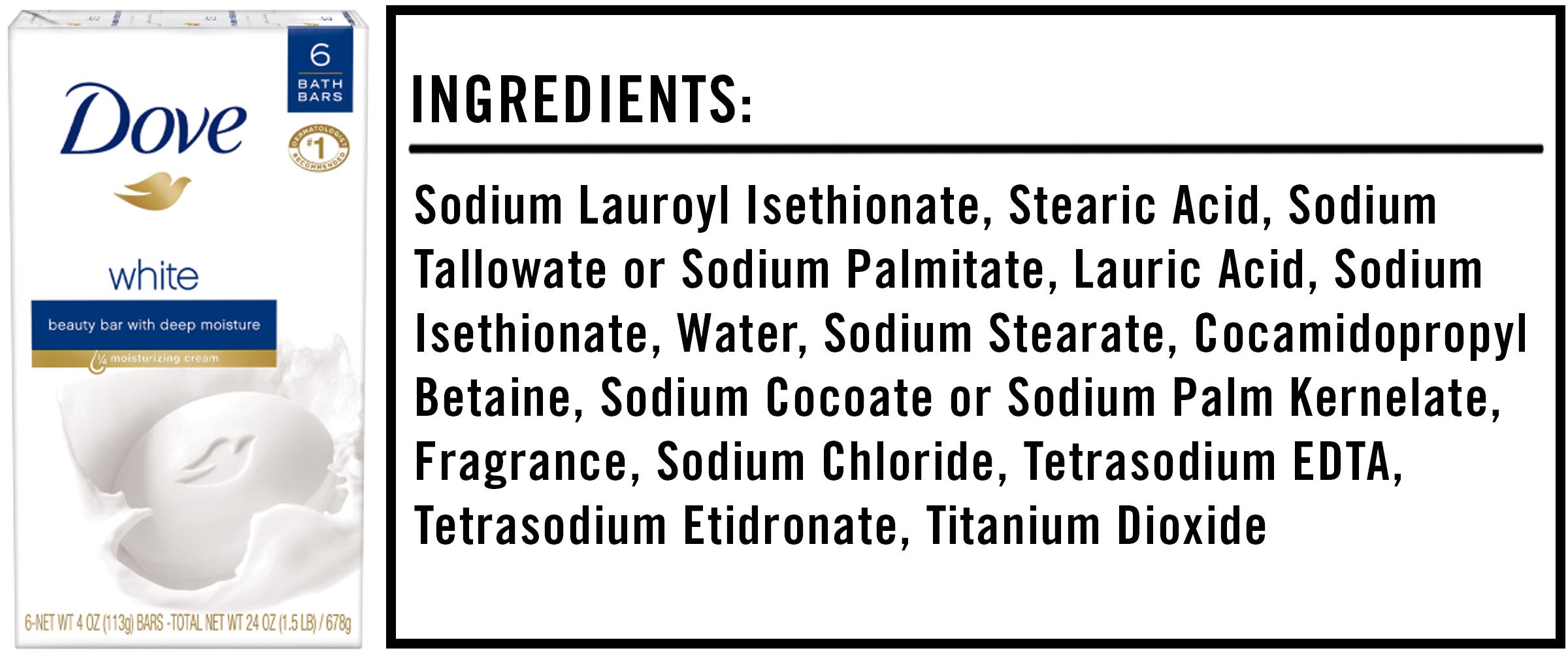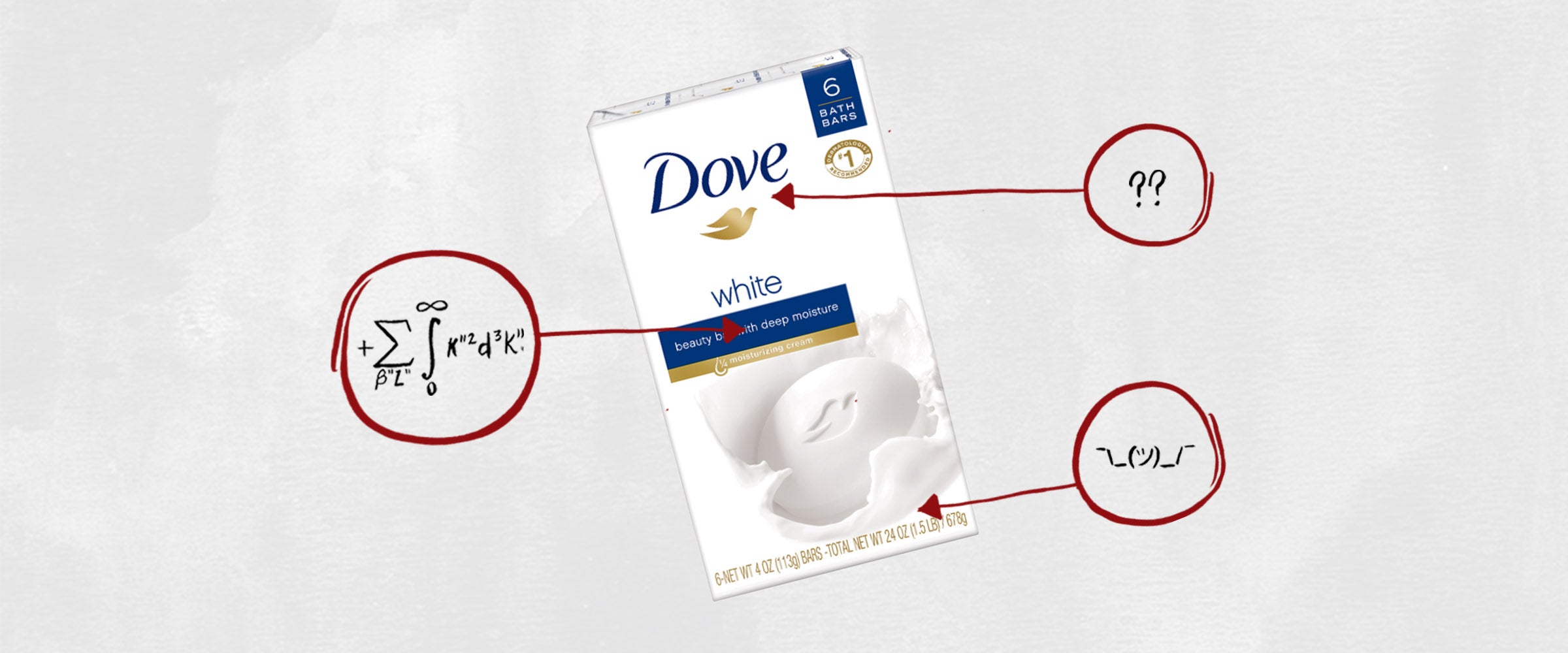We’re often told that you should never eat anything (or put anything on your body) if you don’t recognize everything on the ingredients list. But since most of us have no idea what xanthan gum or potassium benzoate are — or more importantly, what they’re doing to our bodies — we’re decoding the ingredients in the many things Americans put in (and on, or near) themselves.
This edition: Dove White Beauty Bar, which is made from 14 separate ingredients that we’ve broken down in the exact order they appear on their website.
First, though, a couple of words about bar soap compared to liquid soap: While you might be inclined to believe that a dollop of liquid soap is more hygienic than the deteriorated bar soap inhabiting your shower, numerous studies and scientists claim that bar soap, for all intents and purposes, works equally as well as liquid soap. So just use whichever you prefer.
Now, onto the ingredients.

The Ingredients
1) Sodium Lauroyl Isethionate: Sodium lauroyl isethionate is a surfactant, which means it lowers the surface tension between grime and your skin so it can be easily rinsed away. Compared to other common surfactants, especially notoriously harsh ones like sodium laureth sulfate, sodium lauroyl isethionate is considered to be fairly mild.
2) Stearic Acid: Found in animal and vegetable fats, stearic acid is often used as a hardening agent to increase the firmness of bar soaps.
3) Sodium Tallowate or Sodium Palmitate: I suspect that they use one or the other depending on which is cheaper and more available at the time of production, but both of these ingredients do virtually the same thing. Derived from animal tallow, hence the name, sodium tallowate works as a mild surfactant. Sodium palmitate, meanwhile, is usually obtained from vegetable oils and also works as a mild surfactant.
4) Lauric Acid: Lauric acid is found in high amounts in the likes of coconut oil and palm kernel oil, and similar to stearic acid, it contributes to a dense bar of soap and has antibacterial properties that have been shown to combat acne.
5) Sodium Isethionate: Another substance derived from coconut oil, sodium isethionate works as a mild surfactant. Due to its benign nature, sodium isethionate is often found in baby soaps, too.
6) Water: This also comes out of the shower head while you soap up your bod.
7) Sodium Stearate: Yet another vegetable-based material sourced from coconut and palm oils, sodium stearate, once again, works as a thickener and surfactant.
8) Cocamidopropyl Betaine: Derived from coconuts — again — cocamidopropyl betaine is another surfactant. In some cases, the production of this ingredient can result in several impurities that are known to cause allergic reactions. So if you break out in hives or redness after using a product with cocamidopropyl betaine, consider switching over to something else.
9) Sodium Cocoate or Sodium Palm Kernelate: Again, they presumably swap out one of these two ingredients depending on the availability of them. Sodium Cocoate is another simple surfactant made from coconut oil, and palm kernelate is essentially a version of the same thing, but produced from palm kernel oil. While palm oil and palm kernel oil are beneficial for your skin, it should be noted that some soap producers have stopped using them, as their production can be devastating for the environment, especially the habitats of orangutans.
10) Fragrance: Unfortunately, fragrance recipes are considered to be proprietary information, so finding out exactly what produces the smell of this soap is impossible. One thing worth noting, however, is that fragrances tend to be the leading cause of cosmetic contact dermatitis, a skin rash caused by contact with a certain substance. So if this soap makes your skin break out, this ingredient is one of the likely culprits.
11) Sodium Chloride: Sodium chloride, or table salt, is often added to cosmetics to increase the thickness, which could help create a lasting bar of soap.
12) Tetrasodium EDTA: This ingredient functions primarily as a chelating agent, a substance that prevents deterioration and mold growth during processing and storage by binding the minerals within the product. The scientific community continues to waver over whether or not it could be dangerous: Oral exposure to tetrasodium EDTA produces adverse reproductive and developmental effects in animals, but a “final report on the safety assessment of EDTA” claims that it can be safely used in cosmetics.
13) Tetrasodium Etidronate: This is just another name for Tetrasodium EDTA, so I have no idea why they listed it twice.
14) Titanium Dioxide: This basically prevents discoloration. Unfortunately, the European Chemical Agency has concluded that titanium dioxide may cause cancer when inhaled, which might actually be a real concern here.
The Takeaway
While there are several potentially problematic ingredients in this bar soap — namely, titanium dioxide and perhaps cocamidopropyl betaine — most cosmetics sport many, many more. In fact, in extremely simple terms, this soap is mostly just a bunch of coconut and palm juice. So if you tend to have trouble finding soaps that keep your skin hydrated and healthy, you could do far, far worse.

